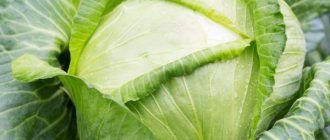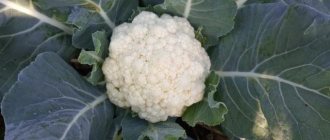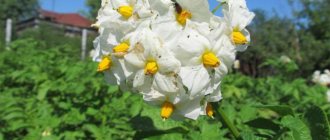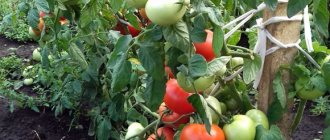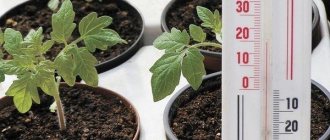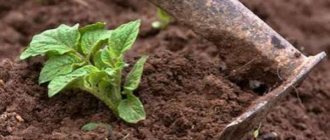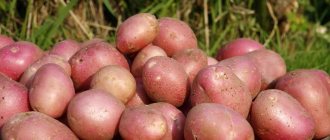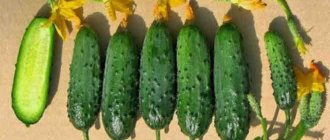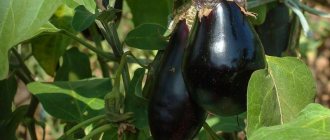Description and characteristics
At the beginning of your acquaintance with a hybrid, we suggest you find out what the plant and its fruits look like, as well as evaluate its advantages and disadvantages.
Did you know? US resident Scott Robb managed to obtain cabbage weighing 63 kg in 2012. Typically, heads of cabbage, depending on the variety, can reach a maximum weight of 15 kg, and the average weight is 2.5 kg.
Appearance of cabbage
The plant grows short. It has dark green leaves with faint pimples and wavy edges. The veins clearly appear on them. They are not harsh when consumed. The lower leaves are located close to the soil surface. The stalk is short.
Heads of cabbage vary in density. They are round-flat in shape. Their insides are white. The average weight of one specimen is from 5 to 7 kg. The taste of the heads of cabbage is sweet and juicy. There is no bitterness in them.
Ripening time and yield
The heads ripen in an average period - 85–90 days pass from the moment of planting seedlings to harvesting. The productivity of the hybrid is high - 20 kg per 1 m², 322–760 kg per 1 ha.
Cold resistance
Cabbage has high resistance to cold. That is why the variety is recommended for cultivation in many regions of Russia, including the northern ones. It can be cultivated both in small summer cottages and on an industrial scale.
Familiarize yourself with the features of planting cabbage before winter.
Worthy qualities and disadvantages of the variety
- Gardeners who have already dealt with the cultivation of Tobia cabbage note the following among its advantages:
- excellent taste of cabbage heads;
- resistance of heads to cracking;
- high yield;
- ability to tolerate transportation well;
- versatility of fruits;
- stable immunity to most diseases of cruciferous crops.
- The disadvantages of the variety include:
- short shelf life;
- the proximity of the lower leaves to the ground, which increases the risk of rot development.
Reviews
Vladimir Ivanovich, Barnaul, 43 years old.
I grew Tobia several years ago. Mid-season hybrid. Pretty good cabbage, if you don’t grow some other, more promising varieties. I didn’t like that despite the late ripening period, cabbage doesn’t last very long. Also, I would not say that it is very tasty when fermented. Strongly inferior to the same Moscow late and other similar varieties.
Irina Yurievna, Kirov, 54 years old.
Normal cabbage. Once upon a time I grew it for 1 year, then I simply couldn’t find the seeds on the market. I can’t speak for sure about her characteristics, but she seemed to be normal. But there are still better and more popular hybrids.
Like every Russian person, I love cabbage. At the dacha, of course, I plant this crop: I try to choose varieties that are productive and have dense heads. One of my favorite varieties is Tobia: this Dutch hybrid is ideal for the Russian climate and demonstrates excellent yield and sustainable qualities. I’ll tell you more about Tobia cabbage and share my opinion about planting and caring for it.
Agricultural technology for growing the Tobia variety
To get the desired level of yield, cabbage should be planted correctly. It should be grown in seedlings. This is how you can protect your garden crops from frost and get the maximum number of sprouts.
The process of planting and growing seedlings consists of several stages:
- pre-sowing preparation of seeds;
- soil preparation;
- seedling care;
- transplanting sprouts to open beds.
Treatment of seeds and soil for sowing
Since Tobia is a hybrid, the seeds must be purchased only in a specialized store. Seed material collected with your own hands or purchased secondhand is not suitable for planting; it does not retain the qualities of the mother plant.
Important! Before sowing seeds, you should read the description on the package. If the manufacturer indicates that they do not need soaking, then this procedure does not need to be performed.
Store-bought seeds do not require treatment with fungicides against fungal infections and culling. The manufacturer has already taken care of this. For better germination, you can place the planting material in water heated to +40...+50°C for a quarter of an hour. Next, dip it in cold water for 2 minutes and dry completely.
Soil for planting can be purchased from a specialized store or mixed with your own hands.
Here are several suitable soil substrate options for growing cabbage seedlings:
- peat + sand (50/50%);
- peat + turf + sand (75/20/5%);
- humus + turf + sand (45/50/5%).
Sowing is carried out in early March, adhering to the following instructions:
- Place a layer of soil substrate 3-4 cm high in the growing container.
- Water with Alerin-B and Gamair (2 tablets/bucket of water).
- After 1–3 days, make furrows 1 cm deep in the soil at a distance of 3 cm from each other.
- Place seed in the furrows at a distance of 1–1.5 cm from each other.
- Cover the seeds with a layer of soil 0.5–1 cm high.
- Place the container in a room where the temperature is maintained at +18…+20°C.
- After the sprouts appear, the temperature should be lowered to +7...+9°C.
We recommend learning how to properly plant and grow cabbage.
Further care of seedlings
Seedlings are picked 7–10 days after the sprouts appear. To do this, take pots with a diameter of 6–8 cm and place in them the same soil that was originally planted, but with the addition of double superphosphate (1 tbsp/1 bucket of mixture) and wood ash (2 tbsp). A low layer of river sand is placed on the soil surface, which will protect the sprouts from blackleg.
The planted plants are placed at a temperature of +17…+18°C. After a couple of days, the daytime temperature is lowered to +13...+14°C, and the night temperature - to +10...+12°C. When the plants have 2 leaves, they are fed with complex mineral fertilizer.
2-2.5 weeks before the expected date of moving the seedlings into open ground, they begin to harden them - they are taken out into fresh air every day, starting from 15-20 minutes, gradually increasing the duration of stay. During the same period, fertilizers are applied a second time. Use urea (1 tbsp) and potassium sulfate (1 tbsp) dissolved in a bucket of water.
Preparing the site and soil in the garden bed
- Cabbage will grow healthy and of high quality if you select a well-lit area for its cultivation, where the following were previously grown:
- carrot;
- potato;
- cucumbers;
- onion;
- beans;
- cereals;
- garlic.
- You should not place it on the beds after:
- cabbage;
- tomatoes;
- radishes;
- turnips;
- beets.
The best cabbage yields are obtained when planted in loamy soils with neutral acidity. Preparatory work on the site must begin in the fall. It needs to be cleared of plant debris, dug deep and fertilized with humus, manure or compost. In the spring, a few weeks before planting seedlings, a mixture of urea (1 tbsp), superphosphate (1 tbsp) and wood ash (1 tbsp) is added to the beds.
Important! According to the rules of crop rotation, cabbage cannot be cultivated in one plot for longer than 2 years in a row. Otherwise, the plant’s productivity decreases and the risk of developing diseases and attacks by harmful insects increases.
Transplanting seedlings into open ground
Seedlings ready for planting in open beds must be strong, 15 cm high, have a developed root system and 5 leaves. Typically these characteristics are observed between 35 and 45 days of age.
The sprouts are moved into the ground from late spring to mid-June using the transshipment method. This means that after removal from the pots, the root system is not cleared of soil, but is replanted together with a lump of earth.
The holes should be slightly wider and deeper than the earthen ball. The gaps between holes should be 45-50 cm, between rows - 50-55 cm.
The recommended planting density for this hybrid is 2.5–3 plants per 1 m². To transplant seedlings, choose a cloudy day. Plantings are covered with agrofibre.
Reviews
Let's find out what gardeners say about Tobia cabbage.
I have had a dacha for a long time, so I have a lot of experience in gardening. Previously, I was afraid to plant hybrid varieties, considering them too capricious and finicky. But the Tobia cabbage variety pleasantly surprised me: it is productive, very tasty, and resistant to cold and disease.
I’ve been planting this variety for five years now and have no complaints. Cabbage ripens well in an open garden even in our cool climate. And since the variety is early, the heads of cabbage are already harvested in July. There is only one minus - the need to buy seeds every year.
Our climate is unstable, so you need to be more careful when choosing varieties for your garden. It is important to choose hardened crops that can withstand temperature changes and cold snaps. Tobia white cabbage is just such a resistant variety. Although it is imported, and even a hybrid, it is not at all capricious and unpretentious. The fruits taste excellent, and are also very dense and juicy.
Cabbage care
Caring for cabbage will not be difficult. It needs watering and fertilizing, loosening and removing weeds, preventive treatments against diseases and parasites.
Watering and fertilizing
Moistening the soil in the beds of newly planted seedlings should be done 3-4 times a week. One sprout will require 2-3 liters of water. During the period of filling the heads of cabbage, moisture must be limited.
A month after planting, it is necessary to establish a watering regime of 1 time per week. For 1 m² you need to pour 10–12 liters of water heated to +18°C and above. The best way to water cabbage is by drip. Sprinkling and furrow irrigation are also good. For normal development and growth of the plant, as well as to obtain a rich harvest, cabbage should be fed.
Important! Watering garden crops with cold water leads to the development of fungal infections.
It is recommended to apply 3-4 fertilizers according to the following schedule:
| Fertilizer application period | Fertilizer Options |
| 2 weeks after moving the seedlings into the ground | Nitrogen-containing mixtures:
|
| 10 days after the first |
|
| Before fruit formation |
|
| In the last month of summer |
|
Loosening and weeding
Regular loosening should be done after the soil is moistened and rain falls. They are necessary to prevent compaction of the top soil layer and improve the moisture and air permeability of the soil. The depth of loosening should be approximately 7 cm.
Cabbage also needs to be hilled. Hilling promotes the growth of lateral roots and improves plant development. During the season, you will need to carry out 2 such procedures: 20 days after planting the seedlings in the ground and after another 10–12 days. From the near-trunk zone at a distance of 25 cm, soil is collected with a glander and sprinkled in a heap against the stem.
Another important and mandatory maintenance activity is weeding. Weeds create shade for light-loving cabbage, which prevents it from developing normally. In addition, they become a source of reproduction of diseases and parasites. Weed the cabbage carefully to avoid damage to the root system.
Pest and disease control
Due to its strong immunity, Tobia cabbage is rarely affected by pathogens or harmful insects. For prevention, the beds are sprinkled with wood ash, tobacco dust, and ground black pepper.
Planting strong-smelling plants between rows that repel pests is effective. These include marigolds, dill, parsley, and marigolds.
The greatest danger can be caused by cabbage caterpillars.
To prevent the butterfly from entering the garden, you can spray with valerian, infusions of pine needles, potato tops, salt, soap-ash solutions. The fight against it is carried out with “Aktofit”, “Fitoverm”, “Bitoxibacillin”, “Aktara”, “Decis”.
Prevention
The description of the Tobia variety indicates that it is not affected by pests and diseases. The breeders made sure that care for this variety was minimal. If desired, you can take some preventive measures.
As a preventative measure, you can scatter wood ash throughout the area. Recommended dosage 2 kg per 1m2. The use of tobacco dust and cayenne pepper will protect the plant from many diseases and pests (moths, cabbage flea beetles, tobacco mosaic or black rot).
Tobia cabbage is one of the Dutch hybrid forms. In 2007, this variety was included in the State Register of the Russian Federation and zoned for cultivation in the following regions of our country:
- North-West.
- Volga-Vyatka.
- Central.
- Srednevolzhsky.
- Uralsk.
- West Siberian.
- East Siberian.
Cabbage is not very common in the Russian Federation, as it has lost ground to more popular hybrids with better advertising campaigns.
In today's publication we will present a detailed description of the Tobia F1 hybrid, show photos, as well as reviews from farmers who were lucky enough to cultivate this vegetable on their plot.
